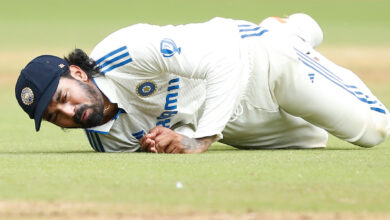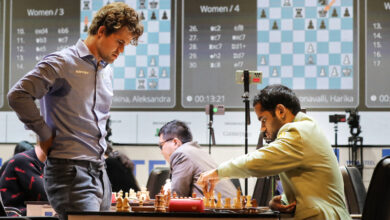Sanju Samson vs Sanju Samson and the myth of a raw deal | Cricket News

Time is running out for Sanju Samson. It sounds absurd. Only the innings before was a half-century; the average is a shade over 50, one in every four outings has been a 50-plus score, the strike-rate is an impressive 101; his ODI-career is still just 15-games old, a time-frame too limited to pass a wholesome judgment. Yet, time is fast running out for Sanju.
You would wonder why. In a conventional sense, you feel he has been judged stringent standards. A game here, another there, reasonable numbers in all, yet why is time running out for him? You grate and grump at the injustice. Not quite, the metrics in measuring the value of a cricketer in shorter versions have changed. Runs are not mere runs anymore. There are hard runs and soft runs, those gritted out in crisis, those breezed when smooth-sailing; those that turned matches around; those that had won games, and those that are of mere academic relevance. A healthy average, bolstered five not outs, would mean nothing unless he has played an innings of substance, one that leaps out of your memory no sooner that you see him on the screen.
He had his breaks. No bigger perhaps an opportunity than at St George’s Park. There was a sufficient cushion of runs, the captain batting regally at the other end, the new-ball defanged, and there were ample overs to make an impact, time to stay relevant in the eyes of the selectors. He got off the mark with a gorgeous square drive, but thereafter the innings descended into a struggle and then into chaos. The pressure of dot balls piled on and the end came inevitably in the form of a drag-on to the stumps. The mode of dismissal is often an outcome of an unsure mind, his hard hands and stiff legs an extension of his mind’s fears and doubts.
Perhaps, he is an immensely gifted cricketer. Perhaps, he will bloom one day. But so far, he has presented an impression that just being there, experiencing the same thing over and over doesn’t necessarily bring wisdom, understanding or development. For all the flickers, it’s becoming increasingly difficult to maintain the faith that there is talent yet to be harnessed from him.
There are other examples of him wasting an opportunity to become a hero. The finest was against South Africa in Lucknow, where he cracked a glorious 86 not out off 63 balls. But in the end, India lost the game nine runs. That India reached so close to South Africa’s total was courtesy of Sanju, but long gone is the era when India’s audience glorified losing causes. The next game, one of his fellow competitors, Ishan Kishan, would seize his break and reel out 93 off 84 balls in a winning deal. Two innings later, he would bludgeon a double hundred to steal ahead of Sanju in the sprint to the World Cup squad. Even two of Sanju’s other half-centuries were at best support acts in high-scoring games. The last—51 off 41—came in a total of 351/5, where he was India’s fourth highest run-getter.
The only strain of sympathy that Sanju deserves is that he was born in the wrong era, perhaps in the wrong century too. He would have been a highly valued commodity, had he plied his trade in the 90s, when India would run pillar to post in search of a wicket-keeper who could bat proficiently, In the post-MS Dhoni era, not only was the bar raised higher for an Indian wicket-keeper but also emerged a raft of dynamic ones. None as exciting as Rishabh Pant, who had already broken several of Dhoni’s records in the longest format and had cracked the ODI code when the accident occurred. KL Rahul stepped in and imperceptibly transformed into an immense one, impressing not just with his keeping but also in judging DRS calls. As has always been the case, you are not judged accepted standards alone, but those of his time too. Hory tells you the stalwarts spinners who missed the international berth in the Spin Quartet milieu or the Ranji run machines who never played a Test in the Fab Four reign.
So, understandably, all that Sanju would get are those games when the regulars are away, or when Rahul is burdened with the duties of being captain, main batsman and keeper, as he had been in this series, that he forsakes one. It’s on him to seize the day. If he does, others like Jitesh Sharma would come rolling along. It’s his only path to the team—in the hybrid role of a wicket-keeper batsman. He had never been in contention as a special batsman, not with his L A average of 33. There was no slots too—the top-order was too crammed. Where would you squeeze him when you have the stardust of Rohit Sharma, Shubman Gill, Virat Kohli, KL Rahul and Shreyas Iyer? No 6 and 7 are often allotted to the all-rounders. Even if not, could Sanju reproduce the explosiveness of Hardik Pandya or Ravindra Jadeja?
Much ire was exhausted on picking Suryakumar Yadav in the World Cup, despite his measly averages. The move failed, but he has been such an irresible talent in T20s to be ignored. But Sanju had not emanated any of such perception-twing talent. He had done little of note in T2OIs, so as to barge his way into the selectors’ consciousness either.
It’s also a myth that he was cut a raw deal. All his 15 appearances have come in the last two years, not a bad frequency for a fringe player. The age too doesn’t benefit him. the time the next World Cup kicks off, he would be 33. Selectors would be tempted to blood those in their early or mid 20s so that they gather ample experience then, those that are setting the IPL charts and domestic cricket on fire.
In short, Sanju’s career has reached such a critical crossroad that unless he produces a knock of incredible substance, his days in international cricket are numbered. Not because he is less skilled, but there are those that are better skilled, those that are more efficient in grabbing opportunities, those that have barged into the mind and memory of selectors, those that have bought their own time. Sanju, no doubt, would get more game time, but time is running out.
Sanju Samson’s slips
South Africa, Gqeberha: India were well placed at 114 for 3 in 26.2 overs. He could have bedded in and scored big, but fell on 12 and precipitated a collapse.
South Africa, Lucknow: From 51 for 4 in 17.4 overs, chasing 250, he resurrected India but could not apply the finishing touches, as India fell short eight runs.
New Zealand, Auckland: Coming at 6, he scored a 38-ball 36, but perished in the 46th over. It was an ideal opportunity to prove his late-over hitting skills. But he failed and India lost seven wickets.
West Indies, Bridgetown: Arrived at No 3 with the score on 90. But lasted just 19 balls (for 9). His struggles against spin bowling on turning tracks was exposed.







